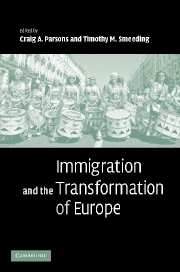Book contents
- Frontmatter
- Contents
- List of figures
- List of tables
- List of contributors
- Acknowledgements
- 1 What's unique about immigration in Europe?
- 2 Europe's immigration challenge in demographic perspective
- 3 Migration into OECD countries 1990–2000
- 4 Divergent patterns in immigrant earnings across European destinations
- 5 Economic consequences of immigration in Europe
- 6 Occupational status of immigrants in cross-national perspective: A multilevel analysis of seventeen Western societies
- 7 Immigrants, unemployment, and Europe's varying welfare regimes
- 8 How different are immigrants? A cross-country and cross-survey analysis of educational achievement
- 9 Immigration, education, and the Turkish second generation in five European nations: A comparative study
- 10 Managing transnational Islam: Muslims and the state in Western Europe
- 11 Migration mobility in European diasporic space
- 12 The new migratory Europe: Towards a proactive immigration policy?
- 13 European immigration in the people's court
- 14 The politics of immigration in France, Britain, and the United States: A transatlantic comparison
- 15 “Useful” Gastarbeiter, burdensome asylum seekers, and the second wave of welfare retrenchment: Exploring the nexus between migration and the welfare state
- 16 The European Union dimension: Supranational integration, free movement of persons, and immigration politics
- 17 The effectiveness of governments’ attempts to control unwanted migration
- Index
- References
3 - Migration into OECD countries 1990–2000
Published online by Cambridge University Press: 23 June 2009
- Frontmatter
- Contents
- List of figures
- List of tables
- List of contributors
- Acknowledgements
- 1 What's unique about immigration in Europe?
- 2 Europe's immigration challenge in demographic perspective
- 3 Migration into OECD countries 1990–2000
- 4 Divergent patterns in immigrant earnings across European destinations
- 5 Economic consequences of immigration in Europe
- 6 Occupational status of immigrants in cross-national perspective: A multilevel analysis of seventeen Western societies
- 7 Immigrants, unemployment, and Europe's varying welfare regimes
- 8 How different are immigrants? A cross-country and cross-survey analysis of educational achievement
- 9 Immigration, education, and the Turkish second generation in five European nations: A comparative study
- 10 Managing transnational Islam: Muslims and the state in Western Europe
- 11 Migration mobility in European diasporic space
- 12 The new migratory Europe: Towards a proactive immigration policy?
- 13 European immigration in the people's court
- 14 The politics of immigration in France, Britain, and the United States: A transatlantic comparison
- 15 “Useful” Gastarbeiter, burdensome asylum seekers, and the second wave of welfare retrenchment: Exploring the nexus between migration and the welfare state
- 16 The European Union dimension: Supranational integration, free movement of persons, and immigration politics
- 17 The effectiveness of governments’ attempts to control unwanted migration
- Index
- References
Summary
Introduction
As the previous chapter showed, many OECD countries expect to face the problem of declining and ageing populations in coming decades. This will impose increasing pressure on their welfare systems. Immigration of young people to these ageing OECD countries is often cited as one of the possible solutions to this problem. However, the opponents of this solution point to the findings of recent studies on immigrants’ economic performance in a number of European countries. They show that immigrants as a group actually tend to be more welfare-dependent than natives (see Riphahn 1999; Hammarstedt 2000; Storesletten 2003; and Wadensjö and Orrje 2002). Thus, increasing the immigration flows may not be a solution to the problem of population ageing, but might instead impose a higher fiscal burden for the receiving economies. This suspicion is strengthened by change in the composition of immigrants to the OECD countries in recent decades. While labor migration flows dominated until the 1970s, refugee immigrants and family reunion migration from non-Western or less developed countries are now growing sources of net immigration in many OECD countries (see Chiswick and Hatton 2002). These immigrants show lower rates of social mobility, skills transferability, and skills acquisition, implying that they have difficulties entering the labor market (see Borjas 1994; and Chiswick 1986, 2000).
- Type
- Chapter
- Information
- Immigration and the Transformation of Europe , pp. 43 - 84Publisher: Cambridge University PressPrint publication year: 2006
References
- 12
- Cited by



